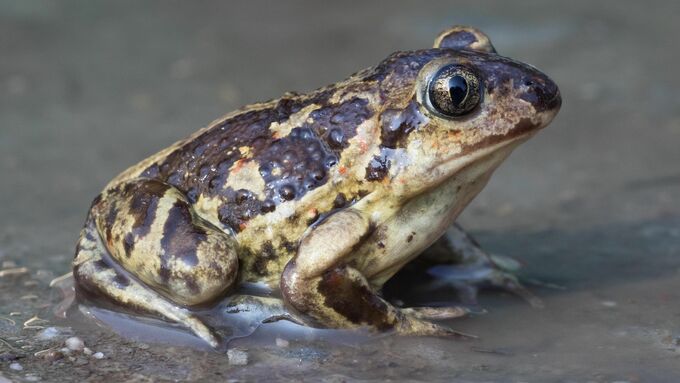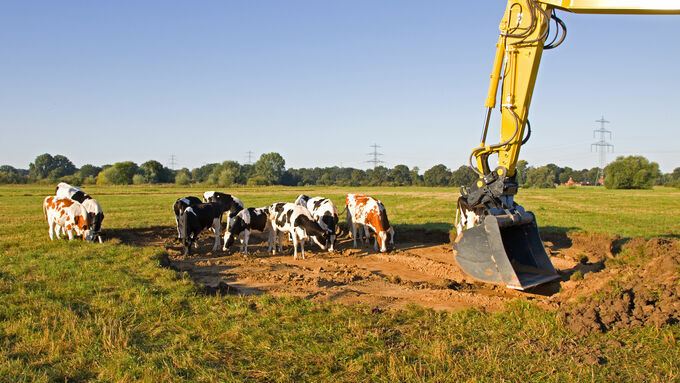The creation of the new waterbodies shall particularly benefit the common spadefoot (Pelobates fuscus). © Photo: Luise Hauswirth, ABU Soest
main content
Project of the month
# 5/2021: BRINKMERSCH AND DISSELMERSCH
Development of two breeding sites for the common spadefoot
In the district of Soest, the river Lippe runs from the ‘Brinkmersch’ near Hangfort to the ‘Disselmersch’ west of Lippborg in slight meanders to small windings. Both areas are part of the nature reserve ‘Lippeaue’. The large meadows and wet grassland areas are mainly used extensively, partly mown and partly grazed by cattle. Partial areas were integrated into the flood dynamics of the river Lippe already in 2005, and the catchment areas were connected to the Lippe floodplain. By this means, the improved water conditions have given the area an outstanding importance as breeding, resting and wintering area for numerous endangered bird species. Many wading and water birds such as the lapwing (Vanellus vanellus), but also songbirds such as red-backed shrike (Lanius collurio), meadow pipit (Anthus pratensis) and common grasshopper warbler (Locustella naevia), as well as various amphibian and dragonfly species find suitable habitats here. Every year, around 150 bird species are observed in the Disselmersch, of which over 70 species also breed. There are also good habitats available for the common spadefoot (Pelobates fuscus).
As part of the LIFE Integrated Project Atlantic Region DE, two areas directly bordering the regularly flooded floodplain of the river Lippe were developed for the common spadefoot in cooperation with the Biological Station Soest. For this, in August 2020, three new breeding waters were created for the species. In addition, the terrestrial habitat was optimised with the sand accrued during the construction of the waterbody. To the west, the areas are connected to the measures carried out in 2017 and 2018 west of Lippstadt and can thus serve as further stepping stones for the distribution of the common spadefoot in the western part of the Lippe floodplain in the district of Soest. In July 2018, 300 tadpoles and metamorphling toads from the breeding station in Ennigerloh had already been released in the Disselmersch. In April 2020, another 750 tadpoles were released. In the immediate vicinity of the newly created waterbodies, there are further suitable breeding waterbodies which might also be stocked with common spadefoot toads if necessary. In the medium term, a connection to the populations in the district of Wesel may be established in this way.
A first success control was carried out in 2021. At the waterbody in which tadpoles and metamorphlings had been released in 2018, more than 40 common spadefoots were recorded at a toad fence during their migration to the release site. Both sexes were represented.
In addition, other species of the Habitats Directive and the Birds Directive also benefit from the creation of the breeding waterbodies, for example crested newt (Triturus cristatus), European tree frog (Hyla arborea) and some wading and water birds such as ruff (Philomachus pugnax), green sandpiper (Tringa ochropus), northern shoveler (Anas clypeata), garganey (Anas querquedula), common teal (Anas crecca) and water rail (Rallus aquaticus). In addition, the conservation status of the crested newt in the Lippe floodplain is very likely to be improved.
Related Topics
Further links
- Nature reserve ‘Lippeaue’ – Landesamt für Natur und Umweltschutz (in German) (external link opens in a new window)
- SAC ‘Teilabschnitte Lippe- Unna, Hamm, Soest, Warendorf’ (DE-4314-302) – Landesamt für Natur und Umweltschutz (in German) (external link opens in a new window)
- SPA ‘VSG Lippeaue zwischen Hamm und Lippstadt mit Ahsewiesen‘ (DE-4314-401) – Landesamt für Natur und Umweltschutz (in German) (external link opens in a new window)
- Arbeitsgemeinschaft Biologischer Umweltschutz im Kreis Soest e. V. + Biologische Station Soest (in German) (external link opens in a new window)





